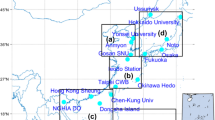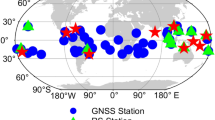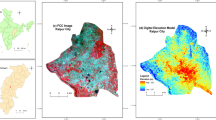Abstract
The long-term (2000–2015) MODIS EOS-Terra/Aqua multi-algorithm (DT, DB and combined DTB) retrieved AOD550 nm and AERONET measured AOD550 nm data at Gandhi College (24.87° N, 84.19° E; 60 m amsl), a rural site in the central IGB, have been employed to assess the performance of MODIS AOD products against AERONET AOD and to examine their annual and inter-annual variability. For both MODIS Terra/Aqua sensors, the linear regression data statistics reveals that the values of slopes for MODIS Terra-EOS sensor lie in the range 1.04 ± 0.03 [DB (QA = 2,3)] to 1.11 ± 0.02 [DT (QA = (2,3)] which are slightly higher than 1. Also, similar observation is noticed for MODIS Aqua-EOS sensor for which slopes of linear regression fit span over 0.99 ± 0.03 [DB (QA = 2,3)] – 1.16 ± 0.03 [DT (QA = 3)]. The intercept, however, approach zero values for both MODIS Terra/AQUA–EOS sensor at DT (QA = 3), DT (QA = 2,3), DB (QA = 2,3) and DTB combined retrieval algorithms. The evaluation/performance analysis, therefore, exhibits the observed near-perfect match of MODIS Terra/Aqua-EOS sensors derived AOD550nm from all algorithms with AERONET measured AOD550 nm as a result of magnitudes of the slope and intercept of the linear regression fit to the scatter diagrams of MODIS AOD550 nm against AERONET AOD550 nm. Results, thus indicate that at Gandhi College, the DT, and DTB combined retrieval algorithms satisfactorily estimate AOD products which can then be used to build aerosol climatology over Gandhi College. The MODIS and AERONET derived AOD550 nm values over the Gandhi College indicate a distinct annual pattern with maximum AOD550 nm during the winter season and minimum AOD550 nm during monsoon season and winter-summer transition period. Analysis revealed that the aerosol loading starts building up over the study region from March to June of the pre-monsoon season mainly due to the high convective activity and long-range mineral dust transport from western arid regions. An increase in AOD values during the post-monsoon and winter season is primarily due to the influx of aerosols from biomass burning processes and stable atmospheric conditions, the MODIS Terra retrieved AOD550 nm using DT and combined DTB algorithm showed higher values in the month of July of monsoon season as compared to MODIS Aqua retrieved AOD550 nm. The inter-annual AOD trend analysis reveals that for MODIS Terra satellite there exits an increasing AOD trend during post-monsoon and winter seasons for DT (0.0233 year–1), DB (0.0239 year–1) and DTB (0.0246 year–1), retrieval algorithms. For MODIS Aqua satellite also, there exists an increasing AOD550 nm trend with differing but higher AOD year–1 trend value. On the contrary, for monsoon and pre-monsoon seasons, for MODIS Terra and Aqua satellite, the AOD trends are found to be statistically insignificant.




Similar content being viewed by others
References
Ackerman AS, Toon OB, Taylor JP, Johnson DW, Hobbs PV, Ferek RJ (2000) Effects of aerosols on cloud albedo: evaluation of Twomey’s parameterization of cloud susceptibility using measurements of ship tracks. J Atmos Sci 57:2684–2695
Ali M, Assiri M (2019) Analysis of AOD from MODIS-merged DT–DB products over the Arabian Peninsula. Earth Syst Environ 3:625–636
Ali MA, Assiri M, Dambul R (2017) Seasonal aerosol optical depth (AOD) variability using satellite data and its comparison over Saudi Arabia for the period 2002? 2013. Aerosol Air Qual Res 17:1267–1280
Ali MA, Bilal M, Wang Y, Qiu Z, Nichol JE, De Leeuw G, Ke S, Mhawish A, Almazroui M, Mazhar U (2022) Evaluation and comparison of CMIP6 models and MERRA-2 reanalysis AOD against Satellite observations from 2000 to 2014 over China. Geosci Front 13:101325
Apte JS, Marshall JD, Cohen AJ, Brauer M (2015) Addressing global mortality from ambient PM2. 5. Environ Sci Technol 49:8057–8066
Banerjee T, Murari V, Kumar M, Raju M (2015) Source apportionment of airborne particulates through receptor modeling: Indian scenario. Atmos Res 164:167–187
Bennouna Y, Cachorro V, Toledano C, Berjón A, Prats N, Fuertes D, Gonzalez R, Rodrigo R, Torres B, De Frutos A (2011) Comparison of atmospheric aerosol climatologies over southwestern Spain derived from AERONET and MODIS. Remote Sens Environ 115:1272–1284
Bilal M, Nichol JE (2017) Evaluation of the NDVI-based pixel selection criteria of the MODIS C6 dark target and deep blue combined aerosol product. IEEE J Sel Top Appl Earth Observ Remote Sens 10:3448–3453
Bilal M, Nichol JE, Wang L (2017) New customized methods for improvement of the MODIS C6 Dark Target and Deep Blue merged aerosol product. Remote Sens Environ 197:115–124
Bilal M, Nazeer M, Qiu Z, Ding X, Wei J (2018) Global validation of MODIS C6 and C6. 1 merged aerosol products over diverse vegetated surfaces. Remote Sens 10:475
Boiyo R, Kumar KR, Zhao T (2017) Statistical intercomparison and validation of multisensory aerosol optical depth retrievals over three AERONET sites in Kenya, East Africa. Atmos Res 197:277–288
Boucher O, Randall D, Artaxo P, Bretherton C, Feingold G, Forster P, Kerminen V, Kondo Y, Liao H, Lohmann U (2013) Climate change 2013: the physical science basis. Contribution of Working Group I to the Fifth Assessment Report of the Intergovernmental Panel on Climate Change. K., Tignor, M., Allen, SK, Boschung, J., Nauels, A., Xia, Y., Bex, V., and Midgley, PM, Cambridge University Press, Cambridge, UK and New York, USA.
Choudhry P, Misra A, Tripathi SN (2012) Study of MODIS derived AOD at three different locations in the Indo Gangetic Plain: Kanpur, Gandhi College and Nainital. Ann Geophys 30:1479–1493
Dey S, Tripathi SN, Singh RP, Holben B (2004) Influence of dust storms on the aerosol optical properties over the Indo-Gangetic basin. J Geophys Res Atmos. https://doi.org/10.1029/2004JD004924
Di Girolamo L, Bond TC, Bramer D, Diner DJ, Fettinger F, Kahn RA, Martonchik JV, Ramana MV, Ramanathan V, Rasch PJ (2004) Analysis of Multi-angle Imaging SpectroRadiometer (MISR) aerosol optical depths over greater India during winter 2001–2004. Geophys Res Lett 31:23115
Eck T, Holben B, Reid J, Dubovik O, Smirnov A, Oneill N, Slutsker I, Kinne S (1999) Wavelength dependence of the optical depth of biomass burning, urban, and desert dust aerosols. J Geophys Res Atmos 104:31333–31349
Forster P, Ramaswamy V, Artaxo P, Berntsen T, Betts R, Fahey DW, Haywood J, Lean J, Lowe DC, Myhre G (2007) Changes in atmospheric constituents and in radiative forcing. Chapter 2. In: Solomon S, Qin D, Manning M, Chen Z, Marquis M, Averyt KB, Tignor M, Miller HL (eds) Climate change 2007: the physical science basis. Cambridge University Press, Cambridge, pp 129–234
Georgoulias A, Alexandri G, Kourtidis K, Lelieveld J, Zanis P, Amiridis V (2016) Differences between the MODIS Collection 6 and 5.1 aerosol datasets over the greater Mediterranean region. Atmos Environ 147:310–319
Haywood JM, Ramaswamy V, Soden BJ (1999) Tropospheric aerosol climate forcing in clear-sky satellite observations over the oceans. Science 283:1299–1303
Hsu N, Jeong MJ, Bettenhausen C, Sayer A, Hansell R, Seftor C, Huang J, Tsay SC (2013) Enhanced Deep Blue aerosol retrieval algorithm: the second generation. J Geophys Res Atmos 118:9296–9315
Jin S, Ma Y, Zhang M, Gong W, Dubovik O, Liu B, Shi Y, Yang C (2019) Retrieval of 500 m Aerosol Optical Depths from MODIS measurements over urban surfaces under heavy aerosol loading conditions in winter. Remote Sens 11:2218
Kahn RA, Gaitley BJ, Garay MJ, Diner DJ, Eck TF, Smirnov A, Holben BN (2010) Multiangle imaging spectroradiometer global aerosol product assessment by comparison with the aerosol robotic network. J Geophys Res Atmos. https://doi.org/10.1029/2010JD014601
Kaufman Y, Koren I, Remer L, Tanré D, Ginoux P, Fan S (2005) Dust transport and deposition observed from the Terra-Moderate Resolution Imaging Spectroradiometer (MODIS) spacecraft over the Atlantic Ocean. J Geophys Res Atmos. https://doi.org/10.1029/2003JD004436
Kumar A (2013) Variability of aerosol optical depth and cloud parameters over North Eastern regions of India retrieved from MODIS satellite data. J Atmos Sol Terr Phys 100:34–49
Kumar A (2014) Long term (2003–2012) spatio-temporal MODIS (Terra/Aqua level 3) derived climatic variations of aerosol optical depth and cloud properties over a semi arid urban tropical region of Northern India. Atmos Environ 83:291–300
Kumar A (2020) Spatio-temporal variations in satellite based aerosol optical depths and aerosol index over Indian subcontinent: impact of urbanization and climate change. Urban Clim 32:100598
Kumar M, Singh R, Murari V, Singh A, Singh R, Banerjee T (2016) Fireworks induced particle pollution: a spatio-temporal analysis. Atmos Res 180:78–91
Kumar M, Raju M, Singh R, Singh A, Singh R, Banerjee T (2017) Wintertime characteristics of aerosols over middle Indo-Gangetic Plain: Vertical profile, transport and radiative forcing. Atmos Res 183:268–282
Kumar M, Parmar K, Kumar D, Mhawish A, Broday D, Mall R, Banerjee T (2018) Long-term aerosol climatology over Indo-Gangetic Plain: Trend, prediction and potential source fields. Atmos Environ 180:37–50
Lawrence M, Lelieveld J (2010) Atmospheric pollutant outflow from southern Asia: a review. Atmos Chem Phys 10:11017–11096
Levy R, Mattoo S, Munchak L, Remer L, Sayer A, Patadia F, Hsu N (2013) The Collection 6 MODIS aerosol products over land and ocean. Atmos Meas Tech 6:2989–3034
Levy R, Munchak L, Mattoo S, Patadia F, Remer L, Holz R (2015) Towards a long-term global aerosol optical depth record: applying a consistent aerosol retrieval algorithm to MODIS and VIIRS-observed reflectance. Atmos Meas Tech 8:4083–4110
Li J, Carlson B, Lacis A (2014a) Application of spectral analysis techniques to the intercomparison of aerosol data–Part 4: Synthesized analysis of multisensor satellite and ground-based AOD measurements using combined maximum covariance analysis. Atmos Meas Tech 7:2531–2549
Li R, Cai H, Fu Y, Wang Y, Min Q, Guo J, Dong X (2014b) The optical properties and longwave radiative forcing in the lateral boundary of cirrus cloud. Geophys Res Lett 41:3666–3675
Mhawish A, Banerjee T, Broday DM, Misra A, Tripathi SN (2017) Evaluation of MODIS Collection 6 aerosol retrieval algorithms over Indo-Gangetic Plain: implications of aerosols types and mass loading. Remote Sens Environ 201:297–313
Mhawish A, Banerjee T, Sorek-Hamer M, Lyapustin A, Broday DM, Chatfield R (2019) Comparison and evaluation of MODIS Multi-angle Implementation of Atmospheric Correction (MAIAC) aerosol product over South Asia. Remote Sens Environ 224:12–28
Mhawish A, Sorek-Hamer M, Chatfield R, Banerjee T, Bilal M, Kumar M, Sarangi C, Franklin M, Chau K, Garay M (2021) Aerosol characteristics from earth observation systems: A comprehensive investigation over South Asia (2000–2019). Remote Sens Environ 259:112410
Misra A, Jayaraman A, Ganguly D (2008) Validation of MODIS derived aerosol optical depth over Western India. J Geophys Res Atmos. https://doi.org/10.1029/2007JD009075
Misra A, Jayaraman A, Ganguly D (2015) Validation of version 5.1 MODIS aerosol optical depth (Deep blue algorithm and dark target approach) over a semi-arid location in Western India. Aerosol Air Qual Res 15:252–262
More S, Kumar PP, Gupta P, Devara PCS, Aher GR (2013) Comparison of aerosol products retrieved from AERONET, MICROTOPS and MODIS over a tropical urban city, Pune, India. Aerosol Air Qual Res 13:107–121
Pandithurai G, Dipu S, Dani KK, Tiwari S, Bisht DS, Devara PCS, Pinker RT (2008) Aerosol radiative forcing during dust events over New Delhi, India. J Geophys Res Atmos. https://doi.org/10.1029/2008JD009804
Sayer A, Hsu N, Bettenhausen C, Jeong MJ, Meister G (2015) Effect of MODIS terra radiometric calibration improvements on collection 6 deep blue aerosol products: validation and terra/aqua consistency. J Geophys Res Atmos 120:12157–12174
Sen A, Abdelmaksoud A, Ahammed YN, Banerjee T, Bhat MA, Chatterjee A, Choudhuri AK, Das T, Dhir A, Dhyani PP (2017) Variations in particulate matter over Indo-Gangetic Plains and Indo-Himalayan Range during four field campaigns in winter monsoon and summer monsoon: role of pollution pathways. Atmos Environ 154:200–224
Sharma V, Ghosh S, Bilal M, Dey S, Singh S (2021) Performance of MODIS C6. 1 dark target and deep blue aerosol products in Delhi national capital region, India: application for aerosol studies. Atmos Pollut Res 12:65–74
Singh P, Vaishya A, Rastogi S (2016) Radiative characterization of aerosols in the central Indo-Gangetic plain. In: SPIE, Remote Sensing of the Atmosphere, Clouds, and Precipitation VI, Proceedings SPIE 9876, p 11
Singh P, Vaishya A, Rastogi S, Babu SS (2020) Seasonal heterogeneity in aerosol optical properties over the subtropical humid region of northern India. J Atmos Sol Terr Phys 201:105246
Sorek-Hamer M, Cohen A, Levy RC, Ziv B, Broday D (2013a) Classification of dust days by satellite remotely sensed aerosol products. Int J Remote Sens 34:2672–2688
Sorek-Hamer M, Strawa A, Chatfield R, Esswein R, Cohen A, Broday D (2013b) Improved retrieval of PM2. 5 from satellite data products using non-linear methods. Environ Pollut 182:417–423
Srivastava A, Tripathi S, Dey S, Kanawade V, Tiwari S (2012) Inferring aerosol types over the Indo-Gangetic Basin from ground based sunphotometer measurements. Atmos Res 109–110:64–75
Stocker T, Qin D, Plattner G, Tignor M, Allen S, Boschung J, Nauels A, Xia Y, Bex V, Midgley P (2013) IPCC, 2013: climate change 2013. The physical science basis. Contribution of working group I to the fifth assessment report of the intergovernmental panel on climate change. Cambridge University Press, Cambridge, p 1535
Tiwari S, Dumka U, Hopke P, Tunved P, Srivastava A, Bisht D, Chakrabarty R (2016) Atmospheric heating due to black carbon aerosol during the summer monsoon period over Ballia: a rural environment over Indo-Gangetic Plain. Atmos Res 178:393–400
Tripathi S, Dey S, Chandel A, Srivastava S, Singh RP, Holben B (2005) Comparison of MODIS and AERONET derived aerosol optical depth over the Ganga Basin. India Ann Geophys 23:1093–1101
Vaishya A, Singh P, Rastogi S, Babu SS (2016) Source apportionment of absorbing aerosols in the central Indo-Gangetic Plain. In: SPIE, Remote Sensing of the Atmosphere, Clouds, and Precipitation VI, Proceedings of SPIE 9876, p 8
Van Donkelaar A, Martin RV, Brauer M, Kahn R, Levy R, Verduzco C, Villeneuve PJ (2010) Global estimates of ambient fine particulate matter concentrations from satellite-based aerosol optical depth: development and application. Environ Health Perspect 118:847–855
Varpe SR, Aher GR, Kolhe AR, More SD (2016) Aerosol-cloud interaction: a case study. In: Volkov K (ed) Aerosols-science and case studies. IntechOpen, London
Varpe SR, Kolhe AR, Kutal GC, Pawar GV, Payra S, Budhavant KB, Aher GR, Devara PC (2018) Heterogeneity in aerosol characteristics at the semi-arid and island AERONET observing sites in India and Maldives. Int J Remote Sens 39:6137–6169
Varpe S, Mahajan C, Kolhe A, Kutal G, Budhavant K, Singh P, Aher G (2022) Aerosol-cloud interaction over south-central India and adjoining coastal areas. Aerosol Sci Eng 6:45–60
Wang K, Sun X, Zhou Y, Zhang C (2017) Validation of MODIS-aqua aerosol products C051 and C006 over the Beijing-Tianjin-Hebei region. Atmosphere 8:172
Wang Y, Ali M, Bilal M, Qiu Z, Ke S, Almazroui M, Islam M, Zhang Y (2021) Identification of aerosol pollution hotspots in Jiangsu Province of China. Remote Sens 13:2842
Acknowledgements
Authors are thankful to Dr. Brent Holben, Principal Investigator and Project Head, NASA AERONET Network. The authors also acknowledge the use of MODIS aerosol products provided by Atmosphere Archive and Distribution System (LAADS) at Goddard Space Flight Center (GSFC), (https://ladsweb.modaps.eosdis.nasa.gov/search/).
Author information
Authors and Affiliations
Corresponding authors
Ethics declarations
Conflict of interest
The authors declare to have no conflict of interests.
Rights and permissions
About this article
Cite this article
Varpe, S.R., Kolhe, A.R., Singh, P. et al. Annual and Inter-annual Variability Coupled with Comparison of MODIS-AERONET Retrieved Aerosol Optical Depth over a Rural Site in the Central Indo-Gangetic Basin. Aerosol Sci Eng 6, 197–211 (2022). https://doi.org/10.1007/s41810-022-00135-8
Received:
Revised:
Accepted:
Published:
Issue Date:
DOI: https://doi.org/10.1007/s41810-022-00135-8




